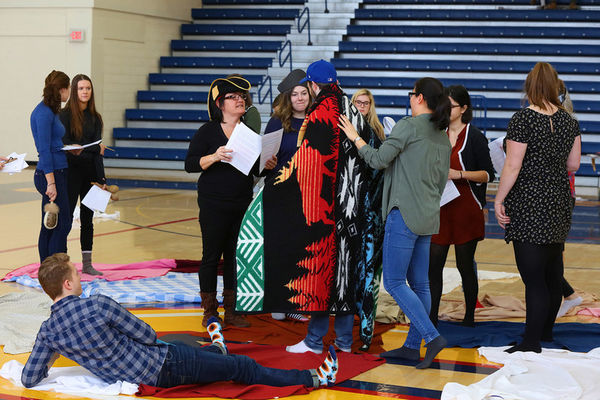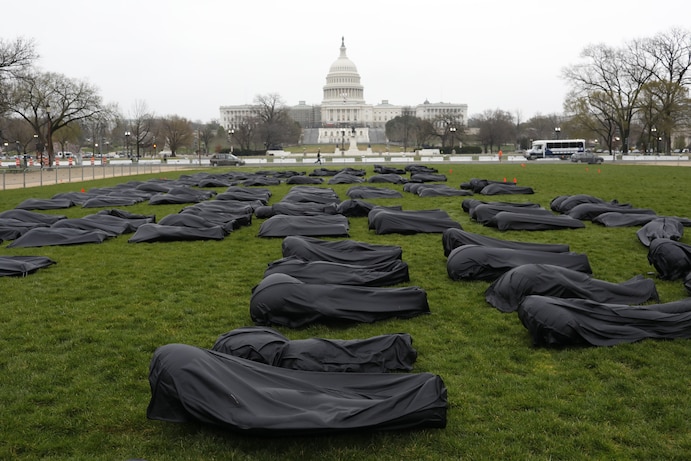Activism that uses art or performance tactics often proves to be effective in raising awareness of social justice issues and demanding, in a very visual and participatory sense, public attention and action.
The first case of activism I want to highlight is the Kairos Blanket Exercise Workshop here in Canada. This exercise raises awareness of Indigenous rights and the colonial history and present reality in Canada by using an immersive and participatory activity. Firstly, this exercise is created by Kairos Canada which is an “ecumenical movement for ecological justice and human rights” that works with various religious organizations and denominations, activists, and advocates for human and environmental rights, including Indigenous peoples and Elders (“Who We Are”). Specifically, the blanket exercise was created in 1997 and developed by Indigenous Elders, educators, and Knowledge Keepers (“Programs”) in collaboration with non-Indigenous members of Kairos Canada to “raise awareness of continuing injustices and impacts of colonization, and to promote further learning” (“About Us”). The blanket exercise uses Indigenous methodologies and asks participants to step onto blankets that represent the land and the participants themselves represent the Indigenous peoples in Canada (“Blanket Exercise Workshop”). The script, read by Indigenous facilitators, Elders, or Knowledge Keepers (“Programs”), guides participants through the shared history of Indigenous and non-Indigenous Canadians by “walking through pre-contact, treaty-making, colonization and resistance” (“Blanket Exercise Workshop”). As the script proceeds and participants respond to cues, the blankets are folded up and taken away to represent how the land was taken away from the Indigenous peoples throughout history and they were forced onto increasingly smaller pieces of land. In this way, the exercise showcases the relationship between Indigenous and non-Indigenous Canadians in history and the present (“Programs”) and attempts to foster understanding, discussion, and empathy (“Blanket Exercise Workshop”). The exercise concludes with a talking circle discussion where participants can share and process their feelings and insights and ask questions to deepen understanding (“Programs”). The following video from Kairos Canada explains the exercise and shows it in action.
The strengths of this exercise include forcing participants to look at the colonial history and present reality of Canada and the injustices Indigenous people face, by immersing them in this reality and having an interactive and experiential experience. By participating, people are forced to think critically about Canadian history, reflect on Canada’s accountability to Indigenous peoples, and realize how non-Indigenous Canadians benefitted and continue to benefit from the harmful history of Canada. In this way, it connects the past to the present in a very physical and literal manner. Furthermore, by immersing people in this reality, the blanket exercise engages the whole person as people experience and respond mentally, emotionally, and physically to the realities of Indigenous peoples in Canada. By provoking such a response, the exercise inspires action towards Indigenous rights and facilitates further discussion and reconciliation between Indigenous and non-Indigenous Canadians. Moreover, by using a group setting, the blanket exercise fosters growth and understanding by encouraging discussion between multiple perspectives and life experiences and promoting interaction with each other.

Despite these strengths, the limitation of the blanket exercise is accessibility as people can only access it through booking the workshop or being involved in a group or school which chooses to participate.
The second case of activism I will showcase is the March For Our Lives installment in Washington, D.C., USA. March For Our Lives, overall, is a movement led by young people which aims to end gun violence and school shootings in the United States by bringing awareness to and addressing “gun glorification, political apathy, poverty, armed supremacy and [the] country’s mental health crisis” which leads to gun violence (“Our Policy Priorities”). It calls for gun control policies and greater community and school safety. It also supports “communities most impacted by gun violence” by providing aid and funding anti-violence work that is led by BIPOC activists and organizations (“Aid and Alliance”). Just recently, on March 24, the group created an art installation to raise awareness of the inaction of politicians in stopping gun violence. The organization used more than 1100 body bags filled with balloons, each representing more than 150 lives lost to gun violence, to spell out “Thoughts and Prayers” on the National Mall in Washington, D.C (Silverman and Moyer). The installation spells out “thoughts and prayers” because the group says that has been the main message from politicians instead of real action on gun control and gun violence. As the movement notes, since their initial march, there have been “170,000+ gun-related deaths, a lot of talk, and not a single federal law to address this crisis” (“Thoughts and Prayers”). The following Tweet describes and shows this installation.
4 years since we marched in DC and around the world to end gun violence. 4 years of #ThoughtsAndPrayers. 4 years of broken promises. 4 years without ANY federal action on guns.
We've asked for the bare minimum. Now we're sending Congress a message they can't ignore. pic.twitter.com/fs9dOq5wSb
— March For Our Lives (@AMarch4OurLives) March 24, 2022
Furthermore, this installation corresponds with a petition calling on the Senate to initiate universal background checks for all gun buyers (Silverman and Moyer). The installation works to pressure the government to act on gun violence. As well, it insists the public see the reality, become aware of the inaction, and join them in pressuring the government for action. The strengths of this art installation include that it provides a powerful message through its stark message and imagery. Both politicians and the public are forced to notice the message and address the reality that thousands of lives are lost due to gun violence and shallow messages of support, instead of real action, do nothing to change that. Since it is on the National Mall, March For Our Lives members are demanding politicians not ignore their message. Additionally, the installation visually connects the numbers of deaths to real lives and people by using body bags. Often, the experiences of real people and communities impacted by gun violence and school shootings are lost in the statistics and numbers. However, using body bags forces people to connect the numbers to real people and real lives lost.

In spite of its strengths, the limitation of this installment is that it is only located in Washington which makes it inaccessible to many people and decreases its impact on those who do not physically encounter it. Furthermore, even though it was posted on social media, the message is lost to those who do not have social media or access to the internet.
Overall, despite accessibility issues, both of these cases of activism successfully bring awareness to the issues they seek to address, force people to pay attention, and inspire action and discussion with their art or immersive performance tactics.
Attributions
Video: Vimeo: KAIROS Canada: https://vimeo.com/129161339?embedded=true&source=video_title&owner=2595505
Tweet: March For Our Lives Twitter account: https://twitter.com/AMarch4OurLives/status/1507090987855880194?cxt=HHwWhIC99ZfRoeopAAAA
Image 2: The Washington Post: https://www.washingtonpost.com/dc-md-va/2022/03/24/parkland-protest-dc-gun-violence/?utm_medium=social&utm_campaign=wp_main&utm_source=twitter
Works Cited
“About Us.” Kairos Blanket Exercise Community, https://www.kairosblanketexercise.org/about-us/.
“Aid and Alliance.” March For Our Lives, https://marchforourlives.com/.
“Blanket Exercise Workshop.” Kairos Canada, https://www.kairoscanada.org/what-we-do/indigenous-rights/blanket-exercise.
“Our Policy Priorities.” March For Our Lives, https://marchforourlives.com/.
“Programs.” Kairos Blanket Exercise Community, https://www.kairosblanketexercise.org/programs/.
Silverman, Ellie and Justin Wm. Moyer. “Parkland shooting survivors return to D.C., with a grim message.” The Washington Post, 24 Mar. 2022, https://www.washingtonpost.com/dc-md-va/2022/03/24/parkland-protest-dc-gun-violence/?utm_medium=social&utm_campaign=wp_main&utm_source=twitter
“Thoughts and Prayers.” March For Our Lives, https://marchforourlives.com/thoughtsandprayers/.
“Who We Are.” Kairos Canada, https://www.kairoscanada.org/who-we-are.